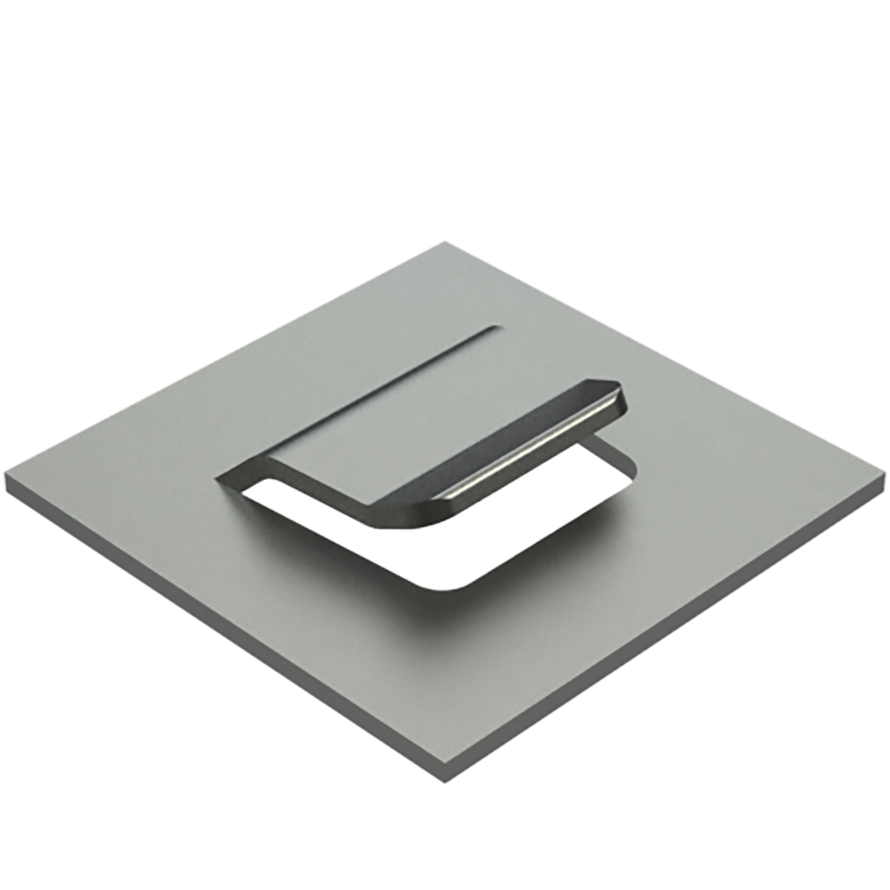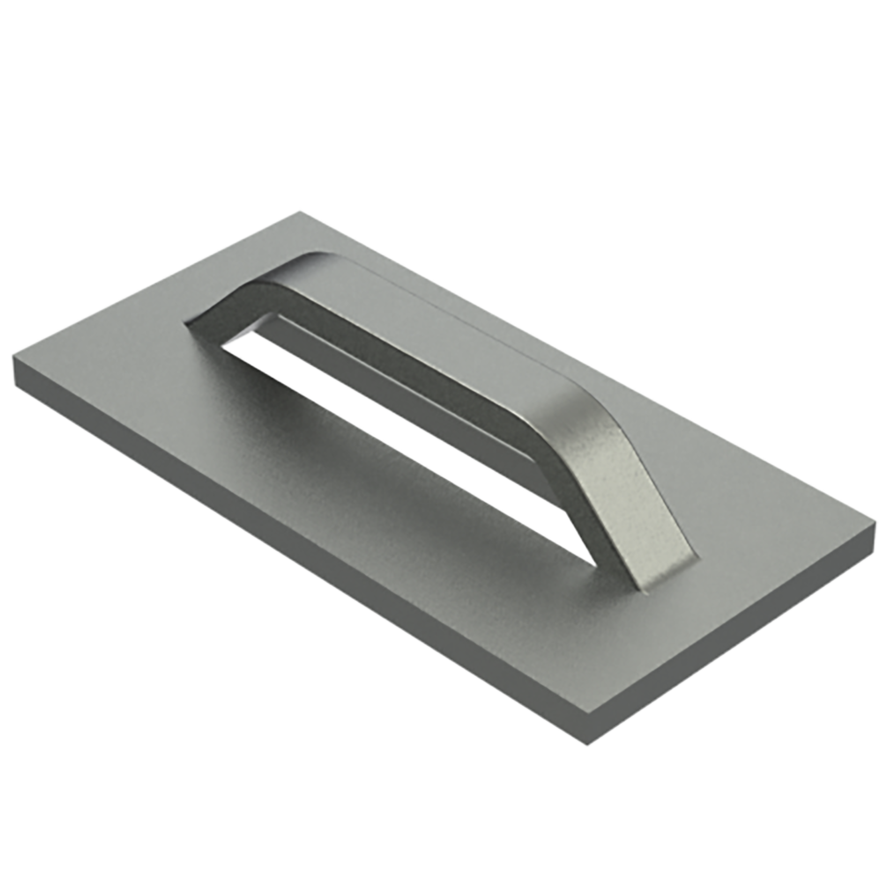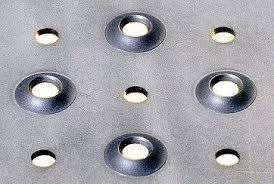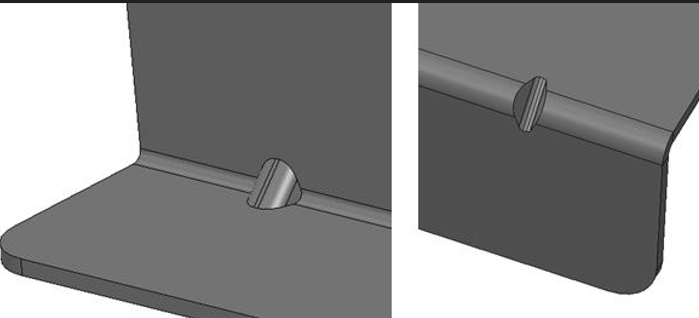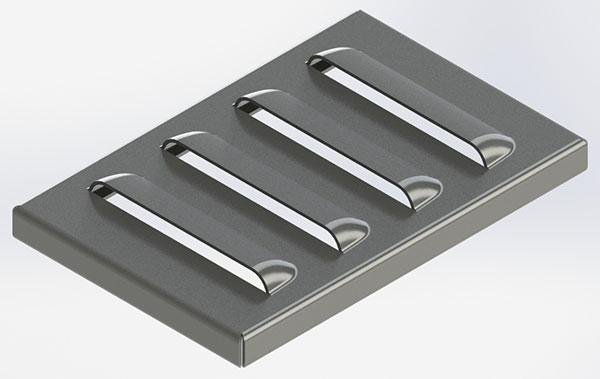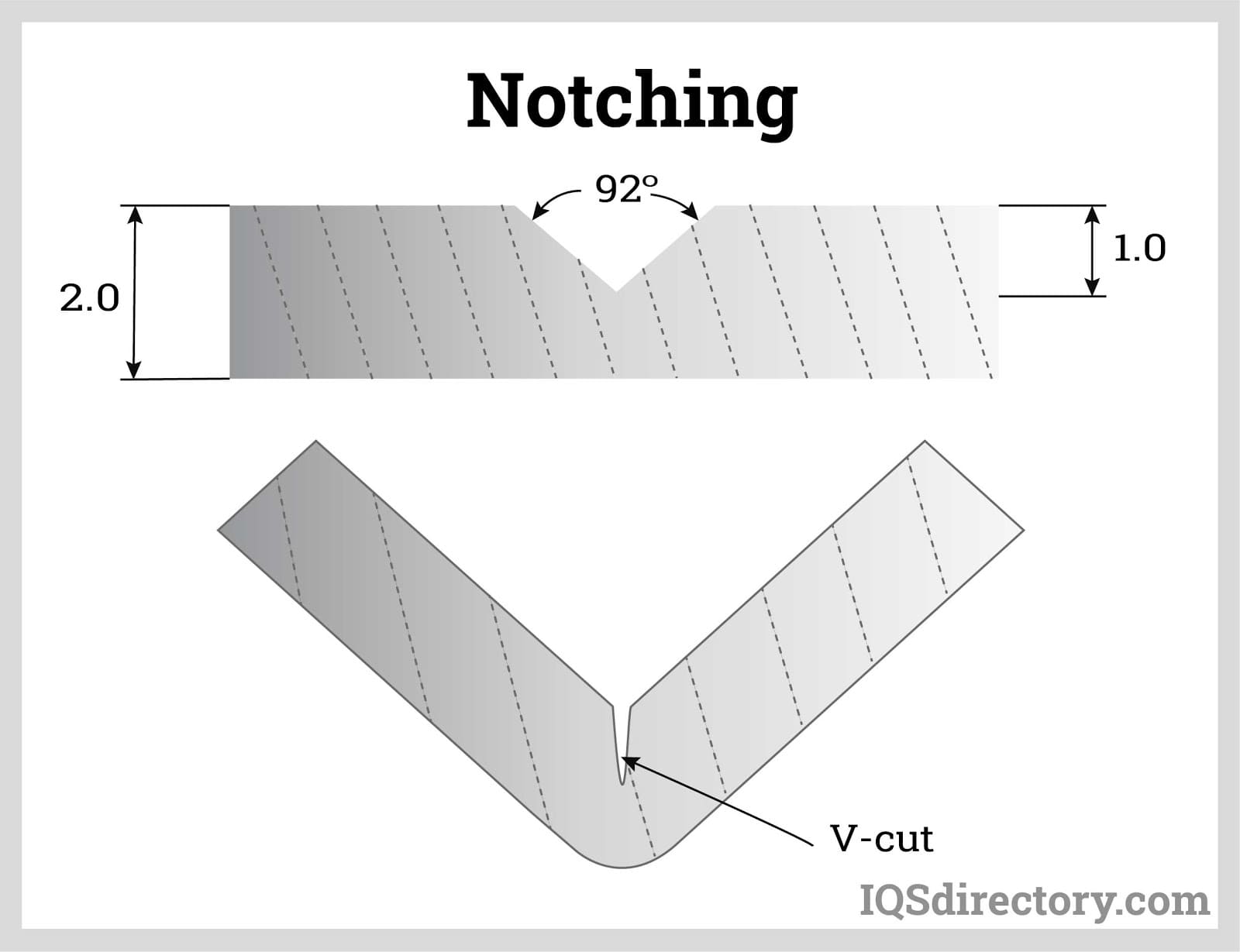There are some special structures or features that are challenging to fabricate for sheet metal prototype parts:
1. Lance (刺破)
In sheet metal fabrication, a lance is a function that creates small, narrow cuts or slits in sheet metal. This cutout is carefully designed to allow the metal to bend or fold along the lines of the cut. Lance are often used to facilitate the bending and forming of complex shapes and structures in sheet metal parts.
Here are some key details and considerations about using lance in sheet metal construction:
Purpose: The lance is used to form predetermined bending lines on metal sheets, thereby achieving precise and controlled bending operations. They are particularly useful for forming fins, flanges, and other features that require sharp bends or complex geometries.
Design Considerations: When incorporating a Lance into the design of a sheet metal part, it is important to consider the material thickness, the angle and length of the lance, and the overall structural integrity of the part. A properly designed lance helps minimize distortion and ensure accurate bends.
Bending process: The lance is usually used in conjunction with a bending machine or other forming equipment to bend the metal plate along the cutting line. The lance provides a clear bend point for consistent and repeatable molding operations.
Material deformation: During the bending process, careful attention must be paid to the possibility of material deformation or cracking near the lance cutout. Proper tooling and bending techniques are critical to minimizing these problems.
Application: Lance are commonly used to manufacture housings, brackets, chassis components and other sheet metal parts that require precise and complex geometries.
2. Bridge (线桥)
In sheet metal parts, bridges are raised portions of material, often used to create paths for cables or wires to pass through. This feature is commonly found in electronic enclosures, control panels, and other devices that require wiring through sheet metal.
The bridge is designed to provide an organized and protected path for cables, preventing them from being pinched, damaged or tangled. It also helps maintain a clean and professional look to the overall assembly.
When designing cable bridges in sheet metal parts, several factors should be considered:
Size and shape: The bridge should be designed to accommodate the size and number of cables that need to pass through it. There should be sufficient clearance and space to prevent overcrowding and to facilitate cable installation and maintenance.
Smooth edges: The edges of the cable tray should be smooth without sharp burrs or rough surfaces to prevent cable damage when passing through.
Mounting and Support: The bridge should be securely mounted to the sheet metal and provide adequate support for the cables. This may involve additional brackets or supports to ensure the stability of the bridge.
EMI/RFI shielding: In some cases, the bridge may need to provide electromagnetic interference (EMI) or radio frequency interference (RFI) shielding to protect the cable from external interference.
Accessibility: The design of the bridge should allow easy access to the cables for maintenance or replacement without having to disassemble the entire sheet metal assembly.
By carefully considering these factors, cable bridges in sheet metal parts can be effectively designed to provide a reliable and organized path for cables, thereby helping to improve the overall functionality and durability of the assembly.
3. Embossing and Ribs (凸包和加强筋)
Embossing involves creating a raised design or pattern on the surface of a metal sheet. It can be challenging to achieve consistent and even embossing without causing deformation or warping of the surrounding areas.
Embossing and ribs are two important features in sheet metal forming that are used to enhance the structural integrity, aesthetics, and functionality of the final part. Here’s a brief overview of each:
Embossing(凸包):
Embossing involves creating a raised design or pattern on the surface of the sheet metal. This can be done for decorative purposes, to display logos or text, or to add texture to the part.
In addition to aesthetics, embossing can also be used to reinforce specific areas of the sheet metal part, providing additional strength and rigidity.
The embossing process typically involves the use of specialized tooling and dies to press the desired pattern or design into the sheet metal.
Ribs(加强筋):
Ribs are raised or indented features that are added to the surface of the sheet metal to increase its stiffness and strength.
Ribs are commonly used to reinforce flat or curved sheet metal panels, preventing them from buckling or deforming under load.
By strategically placing ribs in the design, the overall weight of the part can be reduced while maintaining structural integrity.
The addition of ribs can also improve the part’s resistance to bending, torsion, and other forms of mechanical stress.
Both embossing and ribs are important techniques in sheet metal forming, allowing manufacturers to create parts that are not only visually appealing but also structurally robust and functional. These features are often incorporated into a wide range of products, including automotive components, electronic enclosures, appliance panels, and various consumer goods.
4. Louvers (百叶风口)
Louvers are a type of ventilation system commonly used in sheet metal fabrication. They are designed to allow air to flow through while preventing the entry of water, dirt, or other debris. Louvers are typically made by cutting or punching a series of slits or holes in the sheet metal, and then bending the metal to create a series of angled fins or blades.
Louvers can be used in a variety of applications, including HVAC systems, industrial equipment, automotive components, and architectural features. They are often used to improve airflow and ventilation in buildings, machinery, and vehicles, as well as to provide aesthetic appeal.
In sheet metal fabrication, louvers are typically created using specialized tools such as punch presses, laser cutting machines, or CNC routers. The design and placement of the louvers are carefully calculated to ensure optimal airflow and functionality.
Louvers can be made from a variety of materials, including aluminum, steel, stainless steel, and copper, depending on the specific requirements of the application. They can also be coated or painted to provide additional protection against corrosion and to match the aesthetic of the surrounding environment.
Overall, louvers are an important component in sheet metal fabrication, providing both functional and aesthetic benefits in a wide range of applications.
5. Lugs and Notches(凸耳,切槽)
Lugs and notches are small protrusions or cuts in metal plates used for assembly or interlocking purposes. It can be challenging to create tabs and notches that fit together accurately and securely without causing part misalignment or weak points.
In sheet metal fabrication, lugs and notches are commonly used features that serve various purposes in the design and functionality of the final product.
Lugs:
Lugs are small projections or extensions on a piece of sheet metal that are typically used for attaching or securing other components. They are often used for mounting purposes, such as attaching brackets, fasteners, or other parts to the sheet metal. Lugs can be created through processes such as punching, drilling, or laser cutting, and they are often bent or formed to the desired shape to provide a secure attachment point. Lugs are crucial for ensuring the structural integrity and stability of the final assembly.
Notches:
Notches are indentations or cutouts in the sheet metal that serve various purposes, such as accommodating other components, providing clearance for fasteners, or allowing for the bending or forming of the metal. Notches can be created using processes such as laser cutting, shearing, or punching, and they are often designed to precise dimensions to ensure proper fit and functionality. Notches are essential for enabling the sheet metal to fit into assemblies, align with other components, or facilitate the bending and shaping of the metal without compromising its structural integrity.
Both lugs and notches are critical elements in sheet metal fabrication, and they require careful consideration in the design and manufacturing process to ensure that they meet the specific requirements of the final product. These features play a crucial role in the overall functionality, assembly, and performance of sheet metal components and assemblies.
All these special features are challenging in sheet metal fabrication especially in sheet metal prototyping process without forming tooling. They require careful consideration and expertise in sheet metal prototyping to ensure they are executed accurately and efficiently. HY Metals here are professional in all those tough structures and features. We made a lot of perfect parts with such features.
Post time: Mar-22-2024



